Research on Transient Characteristics of an Aviation Starter Motor Under Low Temperature and Pressure
Abstract
1. Introduction
2. Experimental Setup and Methodology
2.1. Experimental Apparatus
2.2. Experimental Conditions and Data Processing
3. Results and Discussion
3.1. Impact of Low Temperature on Transient Startup Characteristics
3.2. Impact of Low Pressure on Transient Startup Characteristics
4. Conclusions
- For every 5 °C decrease in ambient temperature, the peak starting current increases by 1.95 A. In contrast, the peak starting current was less affected by changes in ambient pressure, with a maximum difference of no more than 4.50 A.
- Within the temperature range of −60 °C to +15 °C, the maximum difference in the starting current pulse width is 11.64 ms, whereas the fluctuations in the starting current pulse width caused by changes in the ambient pressure do not exceed 2 ms.
- As the temperature decreased, the average current after the motor stabilized during startup increased. The changes in the ambient pressure had a relatively small impact on the average starting current, with a variation rate of no more than 2%.
- Within the temperature range of −60 °C to +15 °C, the average speed decreases by 106.20 r/min as the temperature decreases. The impacts of ambient pressure changes on the average starting speed were minimal, with a variation rate of no more than 0.5%.
Author Contributions
Funding
Data Availability Statement
Conflicts of Interest
Nomenclature
| UAV | Unmanned air vehicle |
| DC | Direct current |
| n | Speed of the aviation starting motor |
| Time required for the position of the gear plate to pass through the sensor head | |
| Time required for the missing tooth on the gear plate to pass through the sensor head |
References
- Liu, R.; Huang, K.; Qiao, Y.; Ji, H.; Wu, H. Atomization Characteristics of low-volatility heavy fuel for low-pressure direct injection aviation piston engines. J. Energy Resour. Technol. 2023, 145, 042304. [Google Scholar] [CrossRef]
- Lee, M.; Choi, M.; Yang, T.; Kim, J.; Kim, J.; Kwon, O.; Cho, N. A study on the advancement of intelligent military drones: Focusing on reconnaissance operations. IEEE Access 2024, 12, 55964–55975. [Google Scholar] [CrossRef]
- Mayer, M. The new killer drones: Understanding the strategic implications of next-generation unmanned combat aerial vehicles. Int. Aff. 2015, 91, 765–780. [Google Scholar] [CrossRef]
- Liu, G.; Ruan, C.; Li, Z.; Huang, G.; Zhou, Q.; Qian, Y.; Lu, X. Investigation of engine performance for alcohol/kerosene blends as in spark-ignition aviation piston engine. Appl. Energy 2020, 268, 114959. [Google Scholar] [CrossRef]
- Lei, J.; Xiao, S.; Liu, Y.; Deng, X.; Tian, A.; Dong, L. Multi-objective optimisation of heat transfer and structural strength of aero-piston air-cooled engine cylinder based on orthogonal test. Therm. Sci. Eng. Prog. 2024, 50, 2451–9049. [Google Scholar]
- Jiao, N.; Li, Z.; Mao, S.; Sun, C.; Liu, W. Aircraft brushless wound-rotor synchro-nous starter–generator: A technology review. IEEE Trans. Power Electron. 2023, 38, 7558–7574. [Google Scholar] [CrossRef]
- Zhou, Q.; Hu, X.; Hu, H.; Ye, B.; Wang, Z. Re-search on a low-cost small UAV technology that can be launched at high altitude. Arsenal Equip. Eng. J. 2022, 43, 128–133 + 203. [Google Scholar]
- Li, L.; Zheng, T. Low-cost consumable aircraft and its power development analysis. Aeronaut. Power 2021, 03, 11–14. [Google Scholar]
- Takahashi, N.; Morishita, M.; Miyagi, D.; Nakano, M. Examination of magnetic properties of magnetic materials at high temperature using a ring specimen. IEEE Trans. Magn. 2010, 46, 548–551. [Google Scholar] [CrossRef]
- Naumoski, H.; Riedmüller, B.; Minkowb, A.; Herr, U. Investigation of the influence of different cutting procedures on the global and local magnetic properties of non-oriented electrical steel. J. Magn. Magn. Mater. 2015, 392, 126–133. [Google Scholar] [CrossRef]
- Pronto, A.G.; Neves, M.V.; Rodrigues, A.L. Measurement and separation of magnetic losses at room and cryogenic temperature for three types of steels used in HTS transformers. J. Supercond. Nov. Magn. 2011, 24, 981–985. [Google Scholar] [CrossRef]
- Miyagi, D.; Otome, D.; Nakano, M.; Takahashi, N. Measurement of magnetic properties of nonoriented electrical steel sheet at liquid nitrogen temperature using single sheet tester. IEEE Trans. Magn. 2010, 46, 314–317. [Google Scholar] [CrossRef]
- Yan, C.; Hu, H.; Li, Z.; Zeng, L.; Pei, R. Performance study of high-speed permanent magnet synchronous motor with amorphous alloy considering temperature effect. Materials 2024, 17, 1928. [Google Scholar] [CrossRef]
- Jin, Q. Performance matching of starter and engine. J. Chongqing Univ. Technol. (Nat. Sci. Ed.) 2010, 24, 127–129 + 152. [Google Scholar]
- Milojević, S.; Savić, S.R.; Marić, D.; Stopka, O.; Krstić, B.; Stojanović, B. Correlation between emission and combustion characteristics with the compression ratio and fuel injection timing in tribologically optimized diesel engine. Teh. Vjesn. Tech. Gaz. 2022, 29, 1210–1219. [Google Scholar]
- Mo, W.; Jiangqiang, E.; Zhao, Y. Research on cold start performance of vehicle diesel engine under severe cold conditions. Intern. Combust. Engine Eng. 2022, 08, 65–67. [Google Scholar]
- Kang, J.; Cho, J.; Park, S. Investigation of friction loss characteristics of engine pistons for different engine operating conditions. Int. J. Automot. Technol. 2023, 24, 503–511. [Google Scholar] [CrossRef]
- Skulić, A.; Milojević, S.; Marić, D.; Ivanović, L.; Krstić, B.; Radojković, M.; Stojanović, B. The impact of lubricant viscosity and materials on power losses and efficiency of worm gearbox. Teh. Vjesn. 2022, 29, 1853–1860. [Google Scholar]
- Baranski, M.; Szelag, W.; Lyskawinski, W. Modelling and experimental verification of temperature effects on back electromotive force waveforms in a line start permanent magnet synchronous motor. COMPEL Int. J. Comput. Math. Electr. Electron. Eng. 2022, 41, 1491–1504. [Google Scholar] [CrossRef]
- Agudelo, J.; Agudelo, A.; Pérez, J. Energy and exergy analysis of a light duty diesel engine operating at different altitudes. Rev. Fac. Ing. Univ. Antioq. 2014, 48, 45–54. [Google Scholar] [CrossRef]
- Wang, J.; Cao, E. Hazard analysis and solution of temperature change on motor. Mot. Control Appl. 2009, 36, 42–44. [Google Scholar]
- Chen, M.; Qiu, M. Study on the magnetic properties of iron core materials at low temperature. China Electr. Energy New Technol. 2003, 22, 35–36. [Google Scholar]
- Xu, G. Performance of electrical machines at low temperatures. New Electr. Technol. 1986, 04, 11–13. [Google Scholar]
- Hu, M.; Wang, Z.; Qi, L.; Wei, C. Optimization of motor operating characteristics at low temperature based on RBF-CMGA. J. Mot. Control 2008, 12, 655–665. [Google Scholar]
- Liu, W.; Lin, H. Low-temperature constant resistance torque and improvement of permanent magnet micromotors. In Proceedings of the 10th Anniversary Celebration of the Establishment of Jiangsu Institute of Electrical Technology and the 2004 Academic Annual Meeting, Jiangsu, China, 22–23 October 2004. [Google Scholar]
- Sebastian, T. Temperature effects on torque production and efficiency of PM motors using Nd Fe B Magnets. IEEE Trans. Ind. Appl. 1995, 31, 353–357. [Google Scholar] [CrossRef]
- Kong, X.; Wang, F.; Xing, J. Temperature rise calculation of high-speed PM machine based on thermal-circuit method and 3D fluid field method. In Proceedings of the International Conference on Electrical Machines and Systems, Beijing, China, 20–23 August 2011. [Google Scholar]
- Capponi, F.G.; Terrigi, R.; De Donato, G. A synchronous axial flux PM machine d, q Axes model which takes into account iron losses, saturation and temperature effect on the windings and the permanent magnets. In Proceedings of the International Symposium on Power Electronics, Electrical Drives, Automation and Motion, 2006. SPEEDAM 2006, Taormina, Italy, 23–26 May 2006; pp. 38–44. [Google Scholar]
- Grauers, A.; Kasinathan, P. Force density limits in low-speed PM machines due to temperature and reactance. IEEE Trans. Energy Convers. 2004, 19, 518–525. [Google Scholar] [CrossRef]
- Liu, K.; Zhang, Q.; Chen, J. Online multiparameter estimation of nonsalient-pole PM synchronous machines with temperature variation tracking. IEEE Trans. Ind. Electron. 2011, 58, 1776–1788. [Google Scholar] [CrossRef]
- Kim, S.; Kim, K.; Son, C. Transient system simulation for an aircraft engine using a data-driven model. Energy 2024, 196, 117046. [Google Scholar] [CrossRef]
- Li, Y.; Tian, S.; Lu, Z. Starter matching. Auto Parts 2015, 7, 73–74 + 18. [Google Scholar]
- Zhang, L.; Zhang, X.I. Methods for determining the performance requirements of automobile starters. Automot. Electr. Appl. 2000, 3, 6–7. [Google Scholar]
- Wang, L. Technical requirements of matching starter for diesel engine. Shaanxi Coal 2008, 6, 98–99. [Google Scholar]

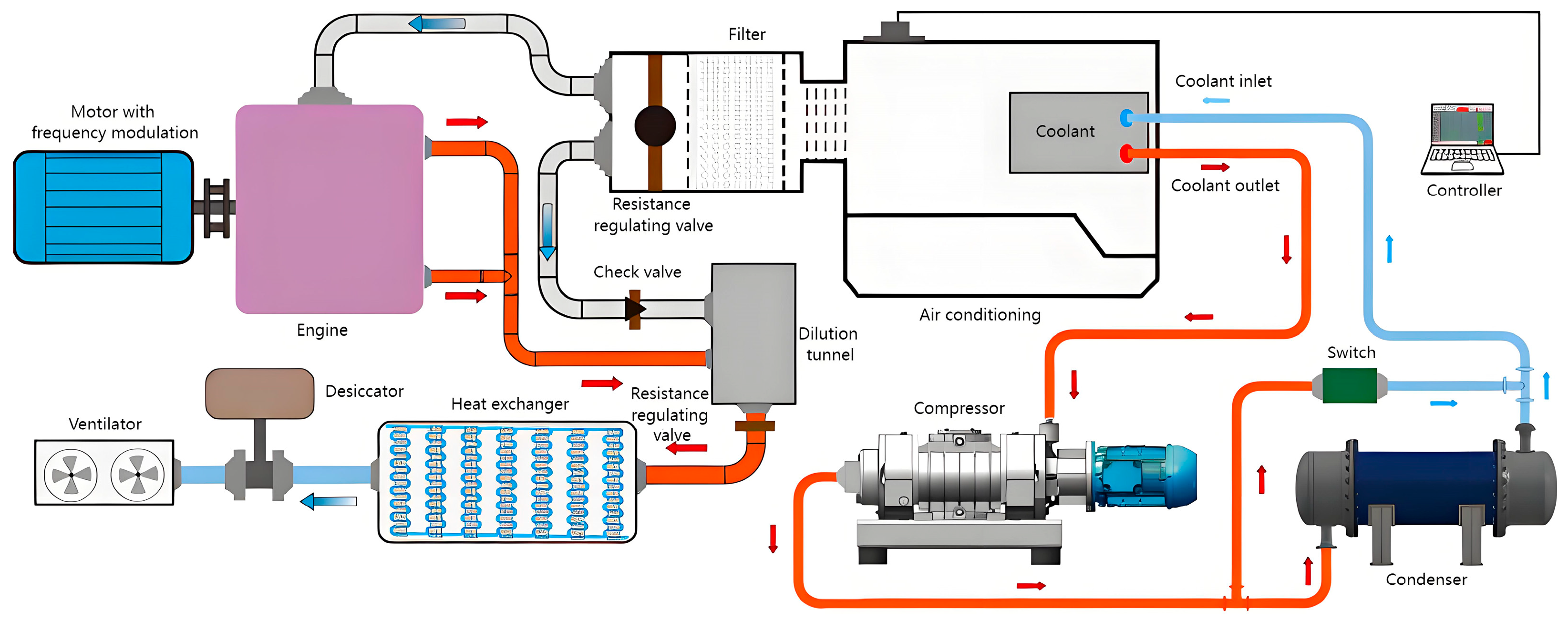
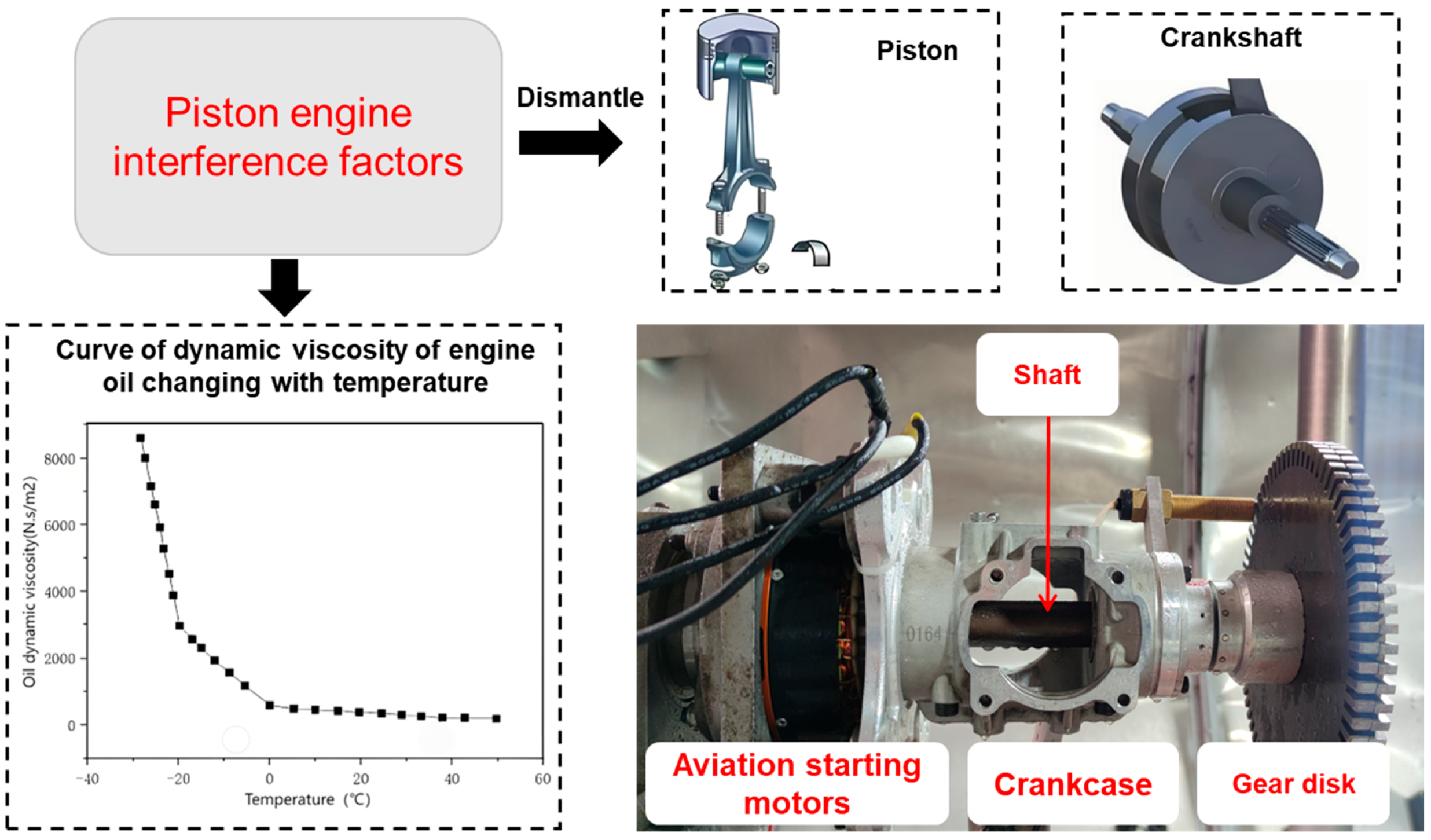
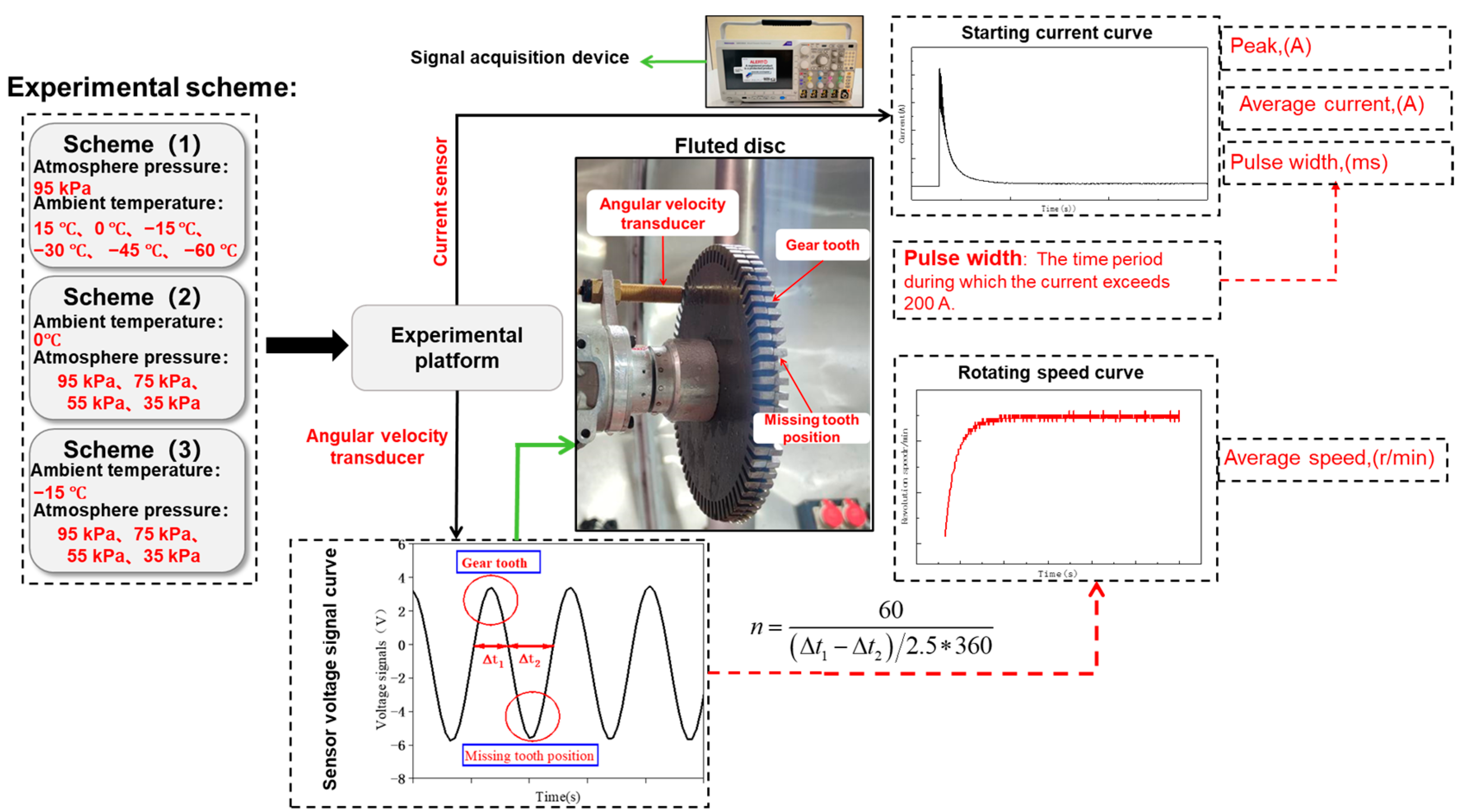

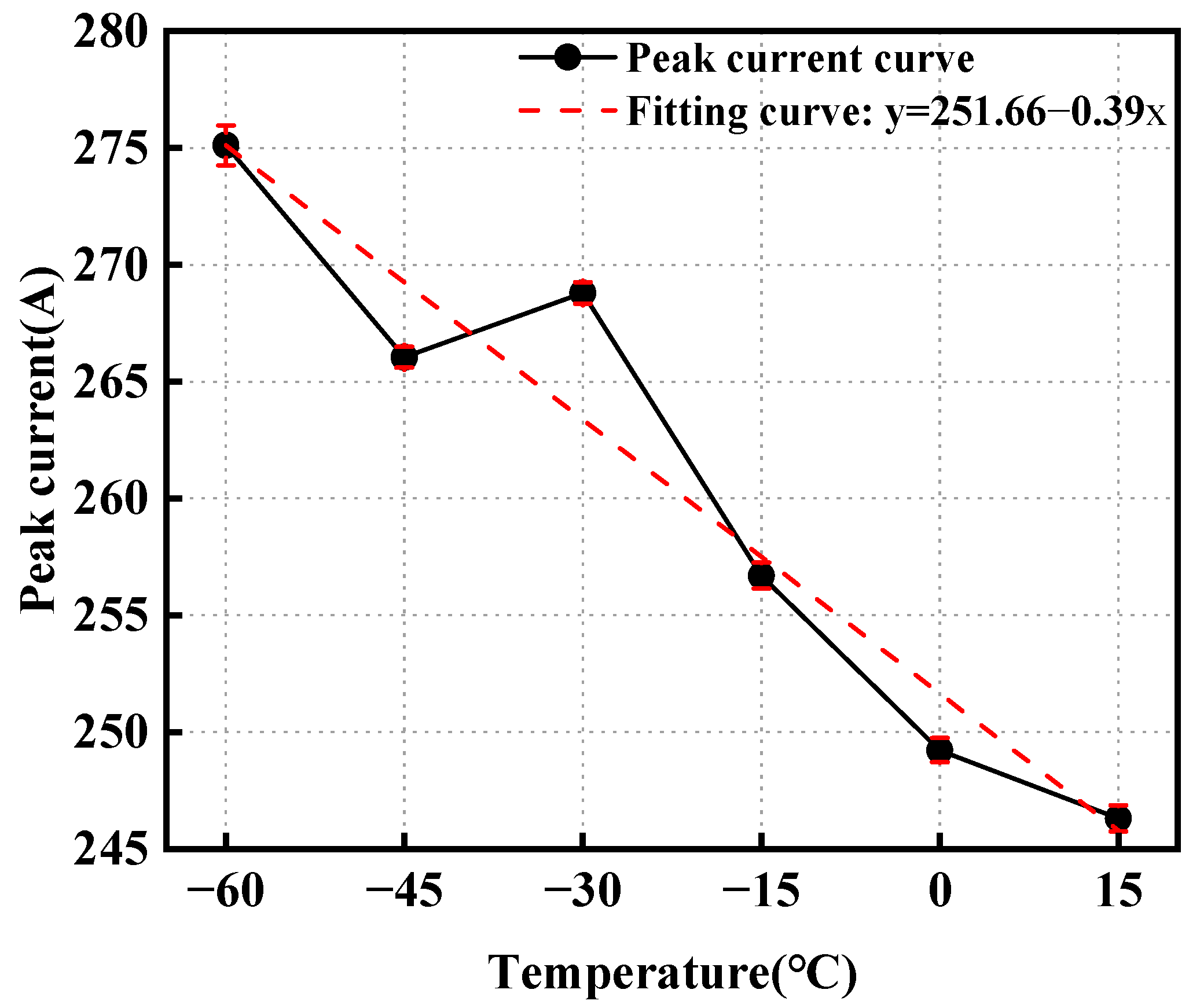

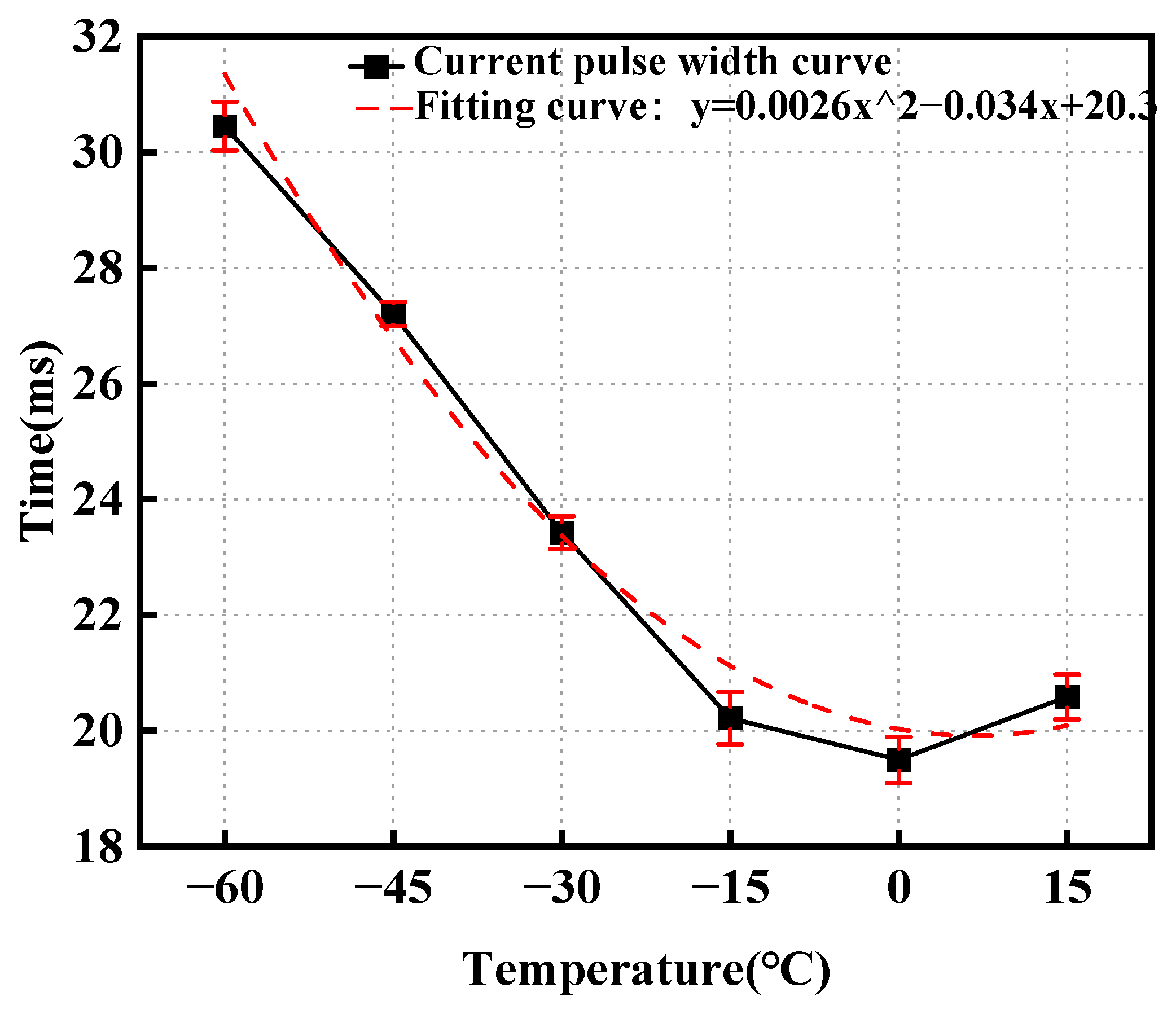
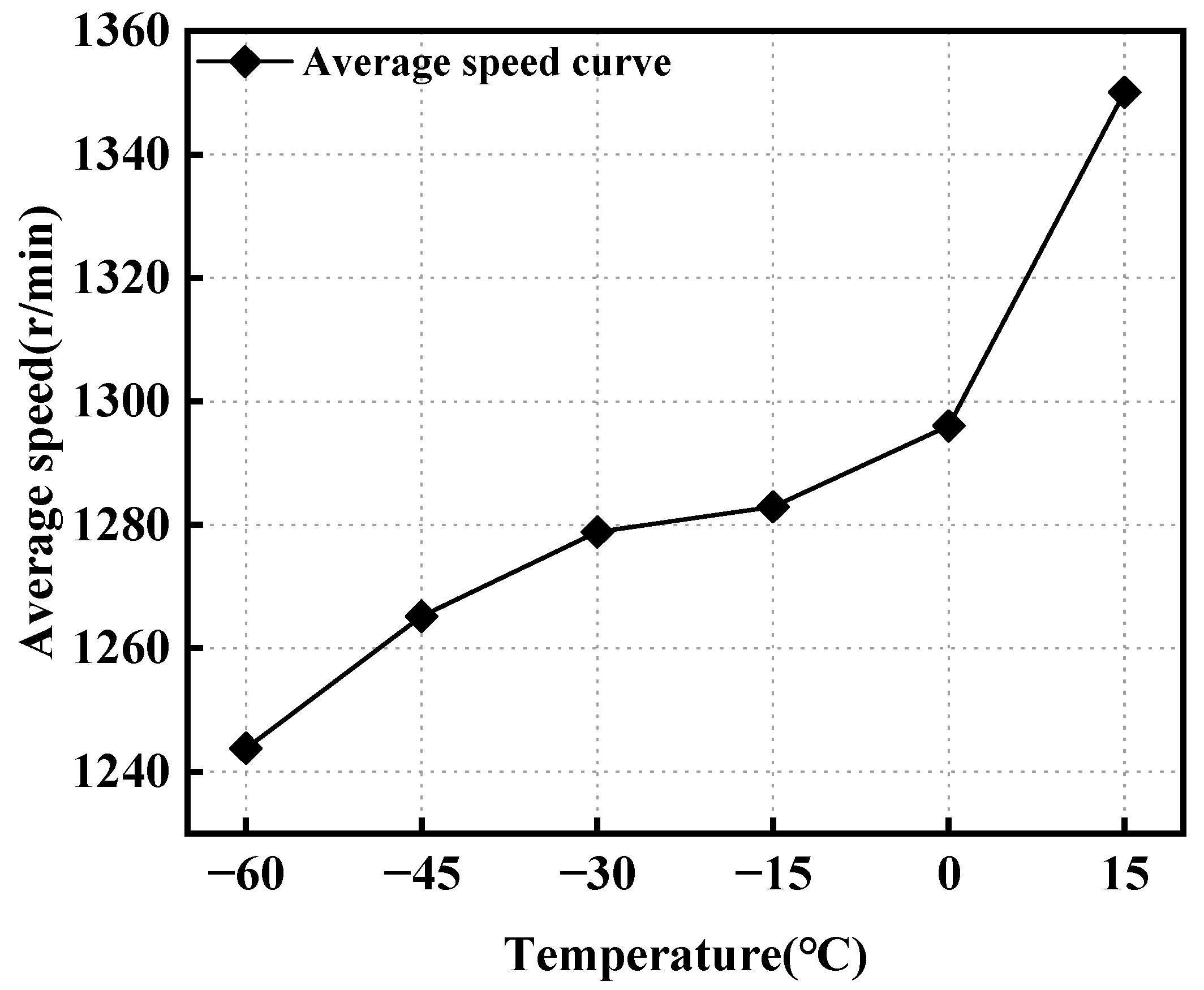
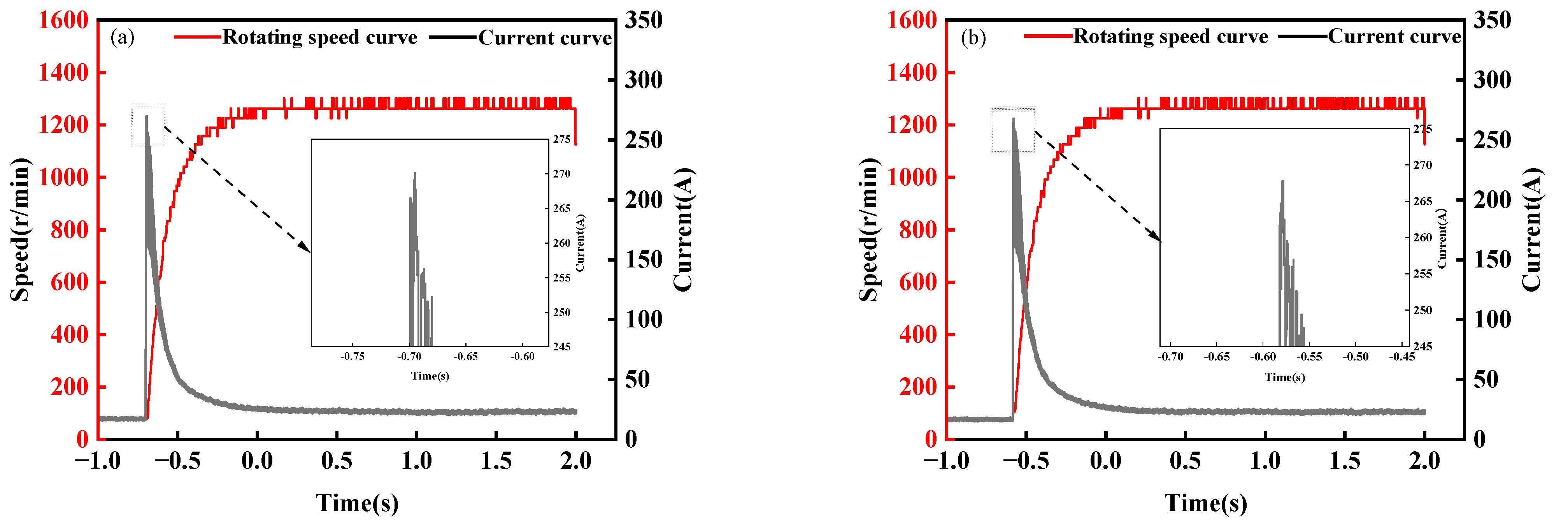
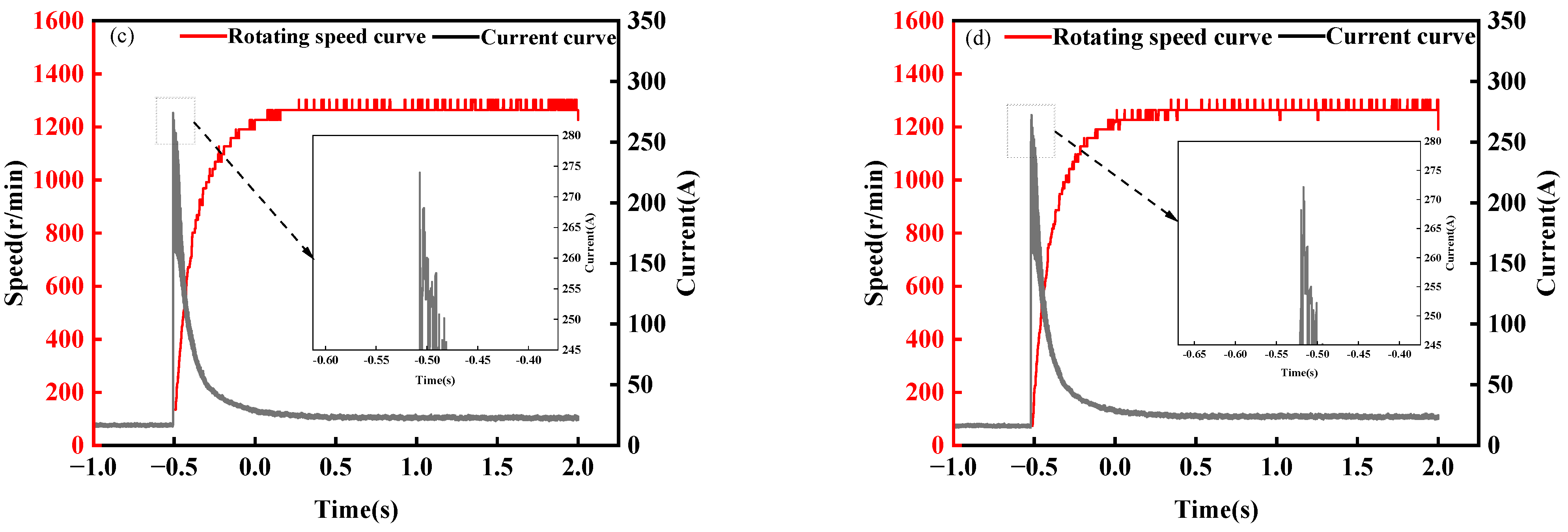
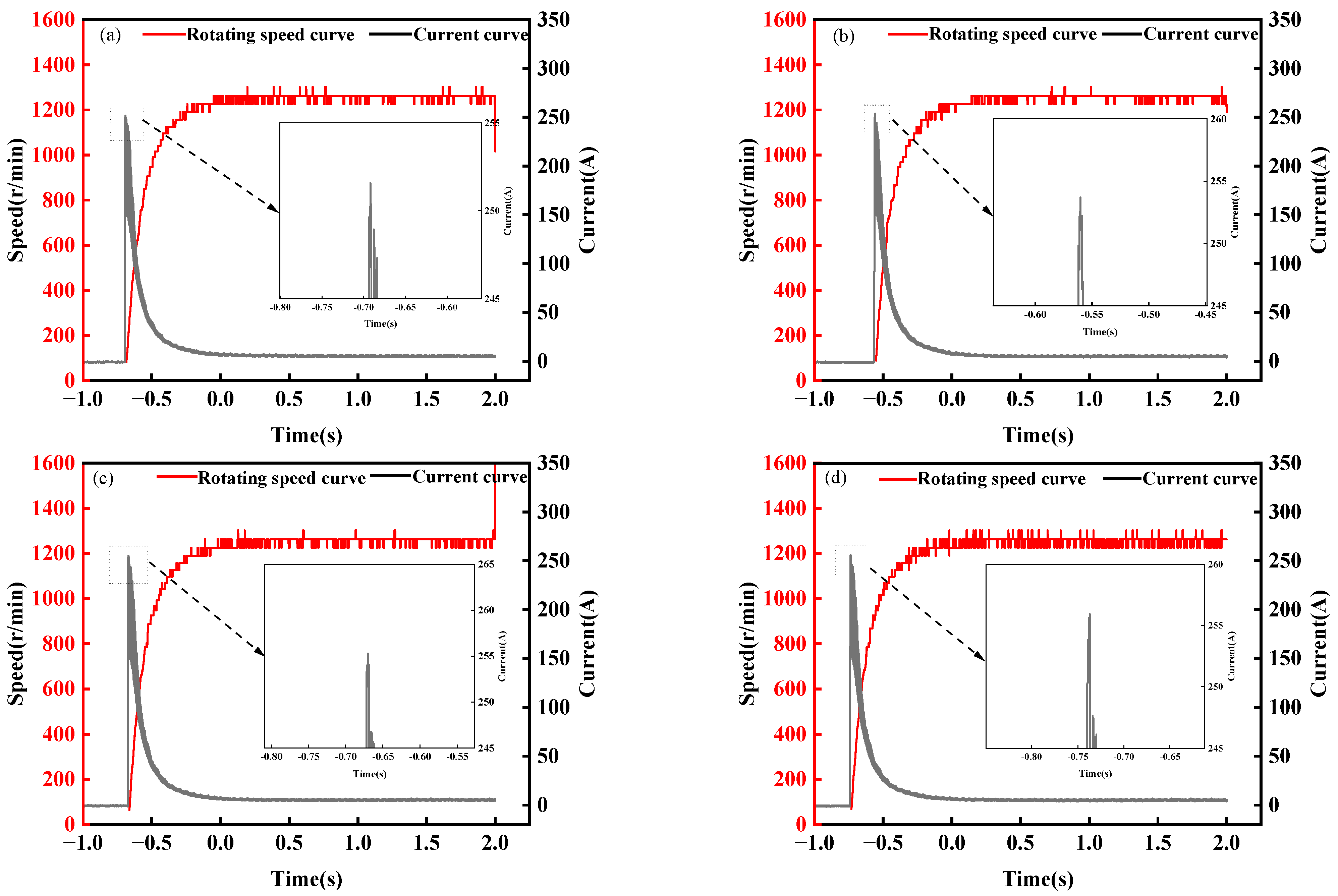

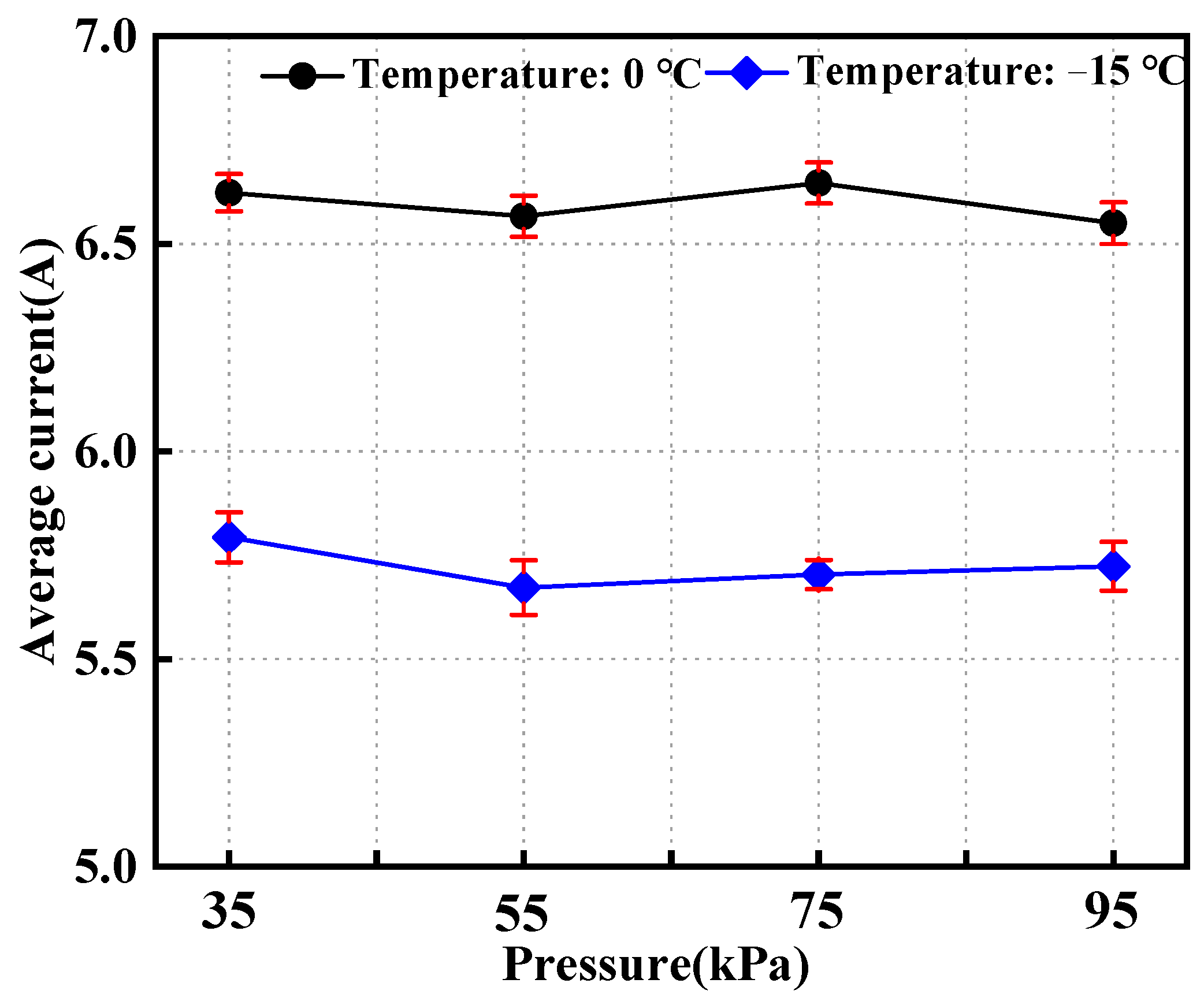
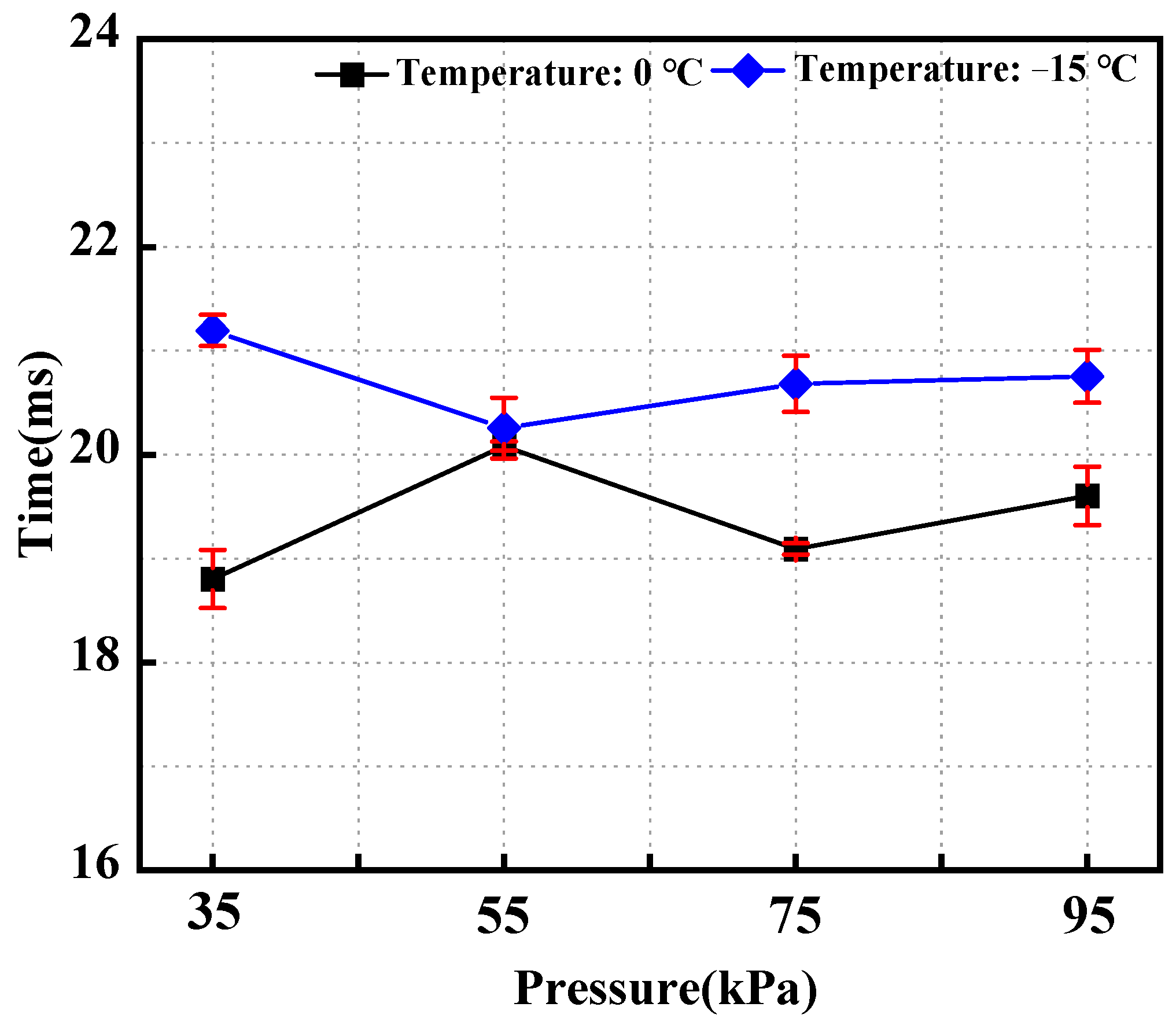
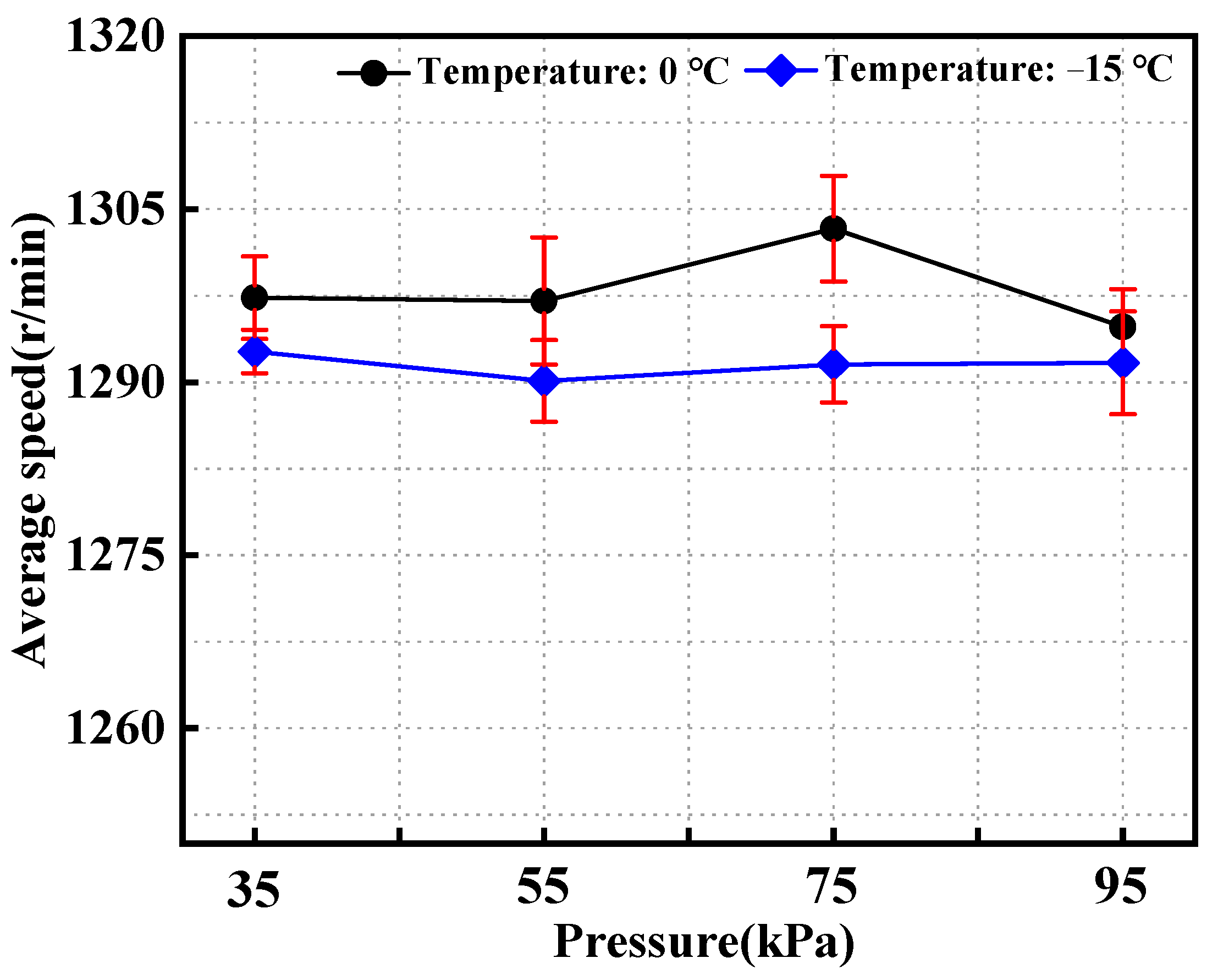
| Item | Parameter |
|---|---|
| Model | GY10000 |
| Cabin size (mm) | 3500 × 3500 × 6000 |
| Temperature range (°C) | −60–50 |
| Temperature fluctuation (°C) | ±0.5 |
| Pressure limit (kPa) | 20–95 |
| Total flow (m3/min) | 70 |
| Mains voltage (V) | 380 |
| Gross power (kW) | 150 |
| Item | Parameter | Item | Parameter |
|---|---|---|---|
| Starting voltage (V) | 26–32 | Power (Kw) | 1.25 (29 V) |
| Stator outer diameter (mm) | 138 | Length of air gap (mm) | 0.75 |
| Rotor cooling diameter (mm) | 152 | Permanent magnet width (mm) | 7.9 |
| Rotor inner diameter (mm) | 139.5 | Permanent magnet thickness (mm) | 4 |
| Number of pole pairs | 20 | Core length (mm) | 26.5 |
| Item | Parameter |
|---|---|
| Cylinder diameter/mm | 66 |
| Stroke/mm | 54 |
| Displacement/ml | 340 |
| Effective compression ratio/- | 6.715 |
| Crank radius/mm | 27 |
| Connecting rod length/mm | 31/6000 |
| Volume before compression/mm3 | 64,005.62 |
| Volume after compression/mm3 | 9532.29 |
| Equipment | Range | Precision |
|---|---|---|
| Current sensor | 0–300 A | 0.01 A |
| Temperature sensor | −200–+200 °C | 1.00 °C |
| Pressure sensor | 0–100 kPa | 1.00 kPa |
| Angular velocity sensor | 50–5000 HZ | 1.00 HZ |
Disclaimer/Publisher’s Note: The statements, opinions and data contained in all publications are solely those of the individual author(s) and contributor(s) and not of MDPI and/or the editor(s). MDPI and/or the editor(s) disclaim responsibility for any injury to people or property resulting from any ideas, methods, instructions or products referred to in the content. |
© 2024 by the authors. Licensee MDPI, Basel, Switzerland. This article is an open access article distributed under the terms and conditions of the Creative Commons Attribution (CC BY) license (https://creativecommons.org/licenses/by/4.0/).
Share and Cite
Tian, W.; Wang, L.; Bai, X.; Han, Z.; Zuo, Z.; Wu, X.; Wu, Y.; Yan, Y.; Fang, J. Research on Transient Characteristics of an Aviation Starter Motor Under Low Temperature and Pressure. Energies 2024, 17, 6258. https://doi.org/10.3390/en17246258
Tian W, Wang L, Bai X, Han Z, Zuo Z, Wu X, Wu Y, Yan Y, Fang J. Research on Transient Characteristics of an Aviation Starter Motor Under Low Temperature and Pressure. Energies. 2024; 17(24):6258. https://doi.org/10.3390/en17246258
Chicago/Turabian StyleTian, Wei, Lin Wang, Xin Bai, Zhiqiang Han, Zinong Zuo, Xueshun Wu, Yi Wu, Yan Yan, and Jia Fang. 2024. "Research on Transient Characteristics of an Aviation Starter Motor Under Low Temperature and Pressure" Energies 17, no. 24: 6258. https://doi.org/10.3390/en17246258
APA StyleTian, W., Wang, L., Bai, X., Han, Z., Zuo, Z., Wu, X., Wu, Y., Yan, Y., & Fang, J. (2024). Research on Transient Characteristics of an Aviation Starter Motor Under Low Temperature and Pressure. Energies, 17(24), 6258. https://doi.org/10.3390/en17246258






